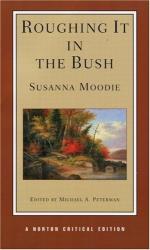At that time I had not the slightest idea but that the farm actually belonged to the land-jobber; and I am to this day unable to tell by what means he succeeded in getting Mr. H—– to part with his property.
The father of Joe H—– had cleared the farm, and while the soil was new it gave good crops; but as the rich surface, or “black muck,” as it is called, became exhausted by continual cropping, nothing but a poor, meagre soil remained.
The early settlers were wretched farmers; they never ploughed deep enough, and never thought of manuring the land. After working the land for several years, they would let it lie waste for three or four years without sowing grass-seeds, and then plough it up again for wheat. The greater part of the hay raised on these farms was sold in the towns, and the cattle were fed during the long severe winter on wheat-straw. The natural result of this poor nourishment was, that their cattle continually degenerated, and great numbers died every spring of a disease called the “hollow horn,” which appears to be peculiar to this country. When the lands became sterile, from this exhausting treatment, they were called “worn-out farms;” and the owners generally sold them to new settlers from the old country, and with the money they received, bought a larger quantity of wild lands, to provide for their sons; by whom the same improvident process was recommenced.
These early settlers were, in fact, only fit for pioneers to a more thrifty class of settlers.
Joe H—–, or “Uncle Joe,” as the country people call any acquaintance, after a fashion borrowed, no doubt, from the Dutch settlers of the State of New York, was, neither by his habits nor industry, likely to become more prosperous than his neighbours of the same thoughtless class. His father had worked hard in his time, and Uncle Joe thought he had a good right to enjoy himself. The nearest village was only five miles from his place, and he was never without some excuse for going thither every two or three days. His horse wanted shoeing, or his plough or waggon wanted “to be fixed” by the blacksmith or carpenter. As a matter of course, he came home “pretty high;” for he was in the constant habit of pouring a half-tumbler of whiskey down his throat, standing bolt upright at the bar of the tavern, after which he would drink about the same quantity of cold water to wash it down. These habits together with bad farming, and a lazy, slovenly helpmate, in a few years made Joe as poor as he could desire to be; and at last he was compelled to sell his farm to Mr. Q—–.




